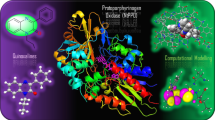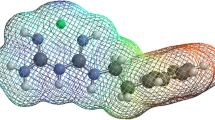Abstract
D-cycloserine inhibits pyridoxal-5′-phosphate (PLP)-dependent enzymes. Inhibition effect depend on organization of the active site and mechanism of the catalyzed reaction. D-cycloserine interacts with the PLP form of the enzyme similarly to the substrate (amino acid), and this interaction is predominantly reversible. Several products of the interaction of PLP with D-cycloserine are known. For some enzymes formation of a stable aromatic product – hydroxyisoxazole-pyridoxamine-5′-phosphate at certain pH – leads to irreversible inhibition. The aim of this work was to study the mechanism of D-cycloserine inhibition of the PLP-dependent D-amino acid transaminase from Haliscomenobacter hydrossis. Spectral methods revealed several products of interaction of D-cycloserine with PLP in the active site of transaminase: oxime between PLP and β-aminooxy-D-alanine, ketimine between pyridoxamine-5′-phosphate and cyclic form of D-cycloserine, and pyridoxamine-5′-phosphate. Formation of hydroxyisoxazole-pyridoxamine-5′-phosphate was not observed. 3D structure of the complex with D-cycloserine was obtained using X-ray diffraction analysis. In the active site of transaminase, a ketimine adduct between pyridoxamine-5′-phosphate and D-cycloserine in the cyclic form was found. Ketimine occupied two positions interacting with different active site residues via hydrogen bonds. Using kinetic and spectral methods we have shown that D-cycloserine inhibition is reversible, and activity of the inhibited transaminase from H. hydrossis could be restored by adding excess of keto substrate or excess of cofactor. The obtained results confirm reversibility of the inhibition by D-cycloserine and interconversion of various adducts of D-cycloserine and PLP.






Similar content being viewed by others
Abbreviations
- Halhy:
-
D-amino acid transaminase from the bacterium Haliscomenobacter hydrossis
- PLP:
-
pyridoxal-5′-phosphate
- PMP:
-
pyridoxamine-5′-phosphate
References
Peisach, D., Chipman, D. M., Van Ophem, P. W., Manning, J. M., and Ringe, D. (1998) D-Cycloserine inactivation of D-amino acid aminotransferase leads to a stable noncovalent protein complex with an aromatic cycloserine-PLP derivative, J. Am. Chem. Soc., 120, 2268-2274, https://doi.org/10.1021/ja973353f.
Fenn, T. D., Stamper, G. F., Morollo, A. A., and Ringe, D. (2003) A side reaction of alanine racemase: transamination of cycloserine, Biochemistry, 42, 5775-5783, https://doi.org/10.1021/bi027022d.
Amorim Franco, T. M., Favrot, L., Vergnolle, O., and Blanchard, J. S. (2017) Mechanism-based inhibition of the Mycobacterium tuberculosis branched-chain aminotransferase by d- and l-cycloserine, ACS Chem. Biol., 12, 1235-1244, https://doi.org/10.1021/acschembio.7b00142.
Dindo, M., Grottelli, S., Annunziato, G., Giardina, G., Pieroni, M., Pampalone, G., Faccini, A., Cutruzzolà, F., Laurino, P., Costantino, G., and Cellini, B. (2019) Cycloserine enantiomers are reversible inhibitors of human alanine:glyoxylate aminotransferase: implications for Primary Hyperoxaluria type 1, Biochem. J., 476, 3751-3768, https://doi.org/10.1042/BCJ20190507.
Malashkevich, V. N., Strop, P., Keller, J. W., Jansonius, J. N., and Toney, M. D. (1999) Crystal structures of dialkylglycine decarboxylase inhibitor complexes, J. Mol. Biol., 294, 193-200, https://doi.org/10.1006/jmbi.1999.3254.
Caminero, J. A., Sotgiu, G., Zumla, A., and Migliori, G. B. (2010) Best drug treatment for multidrug-resistant and extensively drug-resistant tuberculosis, Lancet. Infect. Dis., 10, 621-629, https://doi.org/10.1016/S1473-3099(10)70139-0.
De Chiara, C., Homšak, M., Prosser, G. A., Douglas, H. L., Garza-Garcia, A., Kelly, G., Purkiss, A. G., Tate, E. W., and de Carvalho, L. P. S. (2020) D-Cycloserine destruction by alanine racemase and the limit of irreversible inhibition, Nat. Chem. Biol., 16, 686-694, https://doi.org/10.1038/s41589-020-0498-9.
Priyadarshi, A., Lee, E. H., Sung, M. W., Nam, K. H., Lee, W. H., Kim, E. E., and Hwang, K. Y. (2009) Structural insights into the alanine racemase from Enterococcus faecalis, Biochim. Biophys. Acta, 1794, 1030-1040, https://doi.org/10.1016/j.bbapap.2009.03.006.
Noda, M., Matoba, Y., Kumagai, T., and Sugiyama, M. (2004) Structural evidence that alanine racemase from a D-cycloserine-producing microorganism exhibits resistance to its own product, J. Biol. Chem., 279, 46153-46161, https://doi.org/10.1074/jbc.M404605200.
Wu, D., Hu, T., Zhang, L., Chen, J., Du, J., Ding, J., Jiang, H., and Shen, X. (2008) Residues Asp164 and Glu165 at the substrate entryway function potently in substrate orientation of alanine racemase from E. coli: enzymatic characterization with crystal structure analysis, Protein Sci., 17, 1066-1076, https://doi.org/10.1110/ps.083495908.
Tassoni, R., van der Aart, L. T., Ubbink, M., van Wezel, G. P., and Pannu, N. S. (2017) Structural and functional characterization of the alanine racemase from Streptomyces coelicolor A3(2), Biochem. Biophys. Res. Commun., 483, 122-128, https://doi.org/10.1016/j.bbrc.2016.12.183.
Duff, S. M. G., Rydel, T. J., McClerren, A. L., Zhang, W., Li, J. Y., Sturman, E. J., Halls, C., Chen, S., Zeng, J., Peng, J., Kretzler, C. N., and Evdokimov, A. (2012) The enzymology of alanine aminotransferase (AlaAT) isoforms from Hordeum vulgare and other organisms, and the HvAlaAT crystal structure, Arch. Biochem. Biophys., 528, 90-101, https://doi.org/10.1016/j.abb.2012.06.006.
Bharath, S. R., Bisht, S., Harijan, R. K., Savithri, H. S., and Murthy, M. R. N. (2012) Structural and mutational studies on substrate specificity and catalysis of Salmonella typhimurium D-cysteine desulfhydrase, PLoS One, 7, e36267, https://doi.org/10.1371/journal.pone.0036267.
Braunstein, A. E. (1973) Amino group transfer, The enzymes, (Boyer, P., ed.) Academic Press, N.Y., pp. 379-481, https://doi.org/10.1016/S1874-6047(08)60122-5.
Eliot, A. C., and Kirsch, J. F. (2004) Pyridoxal phosphate enzymes: mechanistic, structural, and evolutionary considerations, Annu. Rev. Biochem., 73, 383-415, https://doi.org/10.1146/annurev.biochem.73.011303.074021.
Toney, M. D. (2011) Controlling reaction specificity in pyridoxal phosphate enzymes, Biochim. Biophys. Acta., 1814, 1407-1418, https://doi.org/10.1016/j.bbapap.2011.05.019.
Soper, T. S., and Manning, J. M. (1981) Different modes of action of inhibitors of bacterial D-amino acid transaminase. A target enzyme for the design of new antibacterial agents, J. Biol. Chem., 256, 4263-4268, https://doi.org/10.1016/s0021-9258(19)69428-7.
Bakunova, A. K., Nikolaeva, A. Y., Rakitina, T. V., Isaikina, T. Y., Khrenova, M. G., Boyko, K. M., Popov, V. O., and Bezsudnova, E. Y. (2021) The uncommon active site of D-amino acid transaminase from Haliscomenobacter hydrossis: biochemical and structural insights into the new enzyme, Molecules, 26, 5053, https://doi.org/10.3390/molecules26165053.
Morrison, J. F., and Walsh, C. T. (1998) The behavior and significance of slow-binding enzyme inhibitors, Adv. Enzymol. Relat. Areas Mol. Biol., 61, 201-301, https://doi.org/10.1002/9780470123072.ch5.
Winter, G., Waterman, D. G., Parkhurst, J. M., Brewster, A. S., Gildea, R. J., Gerstel, M., Fuentes-Montero, L., Vollmar, M., Michels-Clark, T., Young, I. D., Sauter, N. K., and Evans, G. (2018) DIALS: implementation and evaluation of a new integration package, Acta Crystallogr. Sect. D Struct. Biol., 74, 85-97, https://doi.org/10.1107/S2059798317017235.
Collaborative Computational Project, N. 4 (1994) The CCP4 suite: programs for protein crystallography, Acta Crystallogr. Sect. D Biol. Crystallogr., 50, 760-763, https://doi.org/10.1107/S0907444994003112.
Vagin, A., and Teplyakov, A. (1997) MOLREP: an automated program for molecular replacement, J. Appl. Crystallogr., 30, 1022-1025, https://doi.org/10.1107/S0021889897006766.
Murshudov, G. N., Skubák, P., Lebedev, A. A., Pannu, N. S., Steiner, R. A., Nicholls, R. A., Winn, M. D., Long, F., and Vagin, A. A. (2011) REFMAC 5 for the refinement of macromolecular crystal structures, Acta Crystallogr. Sect. D Biol. Crystallogr., 67, 355-367, https://doi.org/10.1107/S0907444911001314.
Emsley, P., and Cowtan, K. (2004) Coot: model-building tools for molecular graphics, Acta Crystallogr. Sect. D Biol. Crystallogr., 60, 2126-2132, https://doi.org/10.1107/S0907444904019158.
Krissinel, E., and Henrick, K. (2004) Secondary-structure matching (SSM), a new tool for fast protein structure alignment in three dimensions, Acta Crystallogr. Sect. D Biol. Crystallogr., 60, 2256-2268, https://doi.org/10.1107/S0907444904026460.
Beeler, T., and Churchich, J. E. (1976) Reactivity of the phosphopyridoxal groups of cystathionase, J. Biol. Chem., 251, 5267-5271, https://doi.org/10.1016/S0021-9258(17)33156-3.
Honikel, K. O., and Madsen, N. B. (1972) Comparison of the absorbance spectra and fluorescence behavior of phosphorylase b with that of model pyridoxal phosphate derivatives in various solvents, J. Biol. Chem., 247, 1057-1064, https://doi.org/10.1016/S0021-9258(19)45615-9.
Delbaere, L. T. J., Kallen, J., Markovic-Housley, Z., Khomutov, A. R., Khomutov, R. M., Karpeisky, M. Y., and Jansonius, J. N. (1989) Complexes of aspartate aminotransferase with hydroxylamine derivatives: spectral studies in solution and in the crystalline state, Biochimie, 71, 449-459, https://doi.org/10.1016/0300-9084(89)90175-2.
Okada, K., Hirotsu, K., Hayashi, H., and Kagamiyama, H. (2001) Structures of Escherichia coli branched-chain amino acid aminotransferase and its complexes with 4-methylvalerate and 2-methylleucine: induced fit and substrate recognition of the enzyme, Biochemistry, 40, 7453-7463, https://doi.org/10.1021/bi010384l.
Peisach, D., Chipman, D. M., Van Ophem, P. W., Manning, J. M., and Ringe, D. (1998) Crystallographic study of steps along the reaction pathway of D-amino acid aminotransferase, Biochemistry, 37, 4958-4967, https://doi.org/10.1021/bi972884d.
Marković-Housley, Z., Schirmer, T., Hohenester, E., Khomutov, A. R., Khomutov, R. M., Karpeisky, M. Y., Sandmeier, E., Christen, P., and Jansonius, J. N. (1996) Crystal structures and solution studies of oxime adducts of mitochondrial aspartate aminotransferase, Eur. J. Biochem., 236, 1025-1032, https://doi.org/10.1111/j.1432-1033.1996.01025.x.
Di Salvo, M. L., Contestabile, R., and Safo, M. K. (2011) Vitamin B(6) salvage enzymes: mechanism, structure and regulation, Biochim. Biophys. Acta, 1814, 1597-1608, https://doi.org/10.1016/j.bbapap.2010.12.006.
Thirstrup, K., Christensen, S., Møller, H. A., Ritzén, A., Bergström, A. L., Sager, T. N., and Jensen, H. S. (2011) Endogenous 2-oxoglutarate levels impact potencies of competitive HIF prolyl hydroxylase inhibitors, Pharmacol. Res., 64, 268-273, https://doi.org/10.1016/j.phrs.2011.03.017.
Funding
This work was supported by the Russian Science Foundation, grant no. 19-14-00164 (in part of kinetic experiments and crystallization of the complex, structure determination and refinement) and by the Ministry of Science and Higher Education of the Russian Federation (in part of spectral investigations). X-ray diffraction experiments were performed with support of the Federal Space Agency of the Russian Federation [project of Space experiments (target works) “Kristallizator”].
Author information
Authors and Affiliations
Contributions
A.K.B. – planning of experiments; E.Yu.B. and V.O.P. – concept and supervision of the study; A.K.B., A.Yu.N., I.O.M., K.M.B. – conducting experiments; A.K.B., I.O.M., K.M.B., E.Yu.B. – discussion of the results of the study; A.K.B., E.Yu.B. – writing the paper; A.K.B., K.M.B., A.Yu.N., E.Yu.B., V.O.P. – editing of the paper.
Corresponding authors
Ethics declarations
The authors declare no conflict of interest in financial or any other sphere. This article does not contain any studies with human participants or animals performed by any of the authors.
Rights and permissions
About this article
Cite this article
Bakunova, A.K., Matyuta, I.O., Nikolaeva, A.Y. et al. Mechanism of D-Cycloserine Inhibition of D-Amino Acid Transaminase from Haliscomenobacter hydrossis. Biochemistry Moscow 88, 687–697 (2023). https://doi.org/10.1134/S0006297923050115
Received:
Revised:
Accepted:
Published:
Issue Date:
DOI: https://doi.org/10.1134/S0006297923050115




